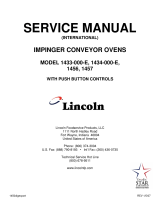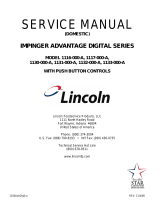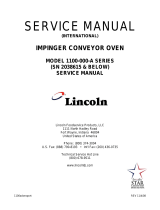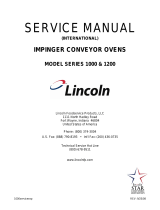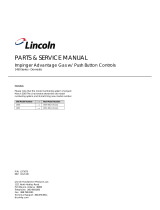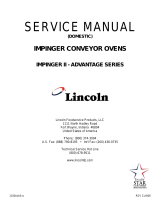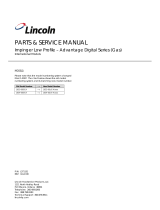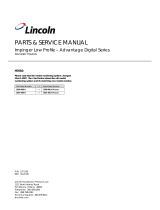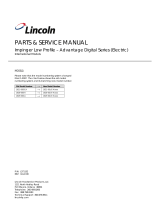Page is loading ...

1100ExAdDig REV: 11/8/07
SERVICE MANUAL
(INTERNATIONAL)
IMPINGER ADVANTAGE DIGITAL SERIES
MODEL 1154-000-EA, 1155-000-EA,
1164-000-EA
WITH PUSH BUTTON CONTROLS
Lincoln Foodservice Products, LLC
1111 North Hadley Road
Fort Wayne, Indiana 46804
United States of America
Phone : (800) 374-3004
U.S. Fax: (888) 790-8193 • Int’l Fax: (260) 436-0735
Technical Service Hot Line
(800) 678-9511
www.lincolnfp.com

Impinger II – Advantage Digital Service Manual - International
2
SEQUENCE OF OPERATIONS
IMPINGER II ADVANTAGE
SERIAL NUMBER 2038616 AND ABOVE
(OVENS WITH PUSH BUTTON CONTROLS)
MODEL 1154-000-EA NAT. GAS 230VAC 50 HZ. 1 PHASE
MODEL 1155-000-EA LP GAS 230VAC 50 HZ. 1 PHASE
POWER SUPPLY Electrical power to be supplied to the oven by a three conductor service.
CONTROL BOX AUTO
COOL DOWN
When the temperature in the control box reaches 120°F ± 3°F (48.9°C ± 1.7°C),
the cooling fan thermostat will switch power to the control box cooling fan. The
thermostat will interrupt power to the cooling fan when the control box temperature
falls to 100°F ± 3°F (37.8°C ± 1.7°C).
MAIN FAN CIRCUIT Power is permanently supplied, through a 10 amp oven fuse, through a normally
closed control box hi-limit thermostat (opens at 140°F, 60°C), to the normally open
double pole oven fan switch and to the cooling fan. Closing the oven fan switch
supplies line voltage to the main fan motor. Closing the main fan switch also
supplies voltage to the cooling fan, the primary of the control transformer, the
conveyor motor, and the burner system.
BURNER CIRCUIT Closing the oven fan switch supplies line voltage through the normally open gas
pressure switch (located in the gas valve and closed when gas pressure is
present), through the normally open air pressure switch (closed by the air pressure
from the main fan), through the normally closed oven cavity hi-limit thermostat
(opens at 662°F, 350°C), and to the ignition control.
IGNITION CONTROL The ignition control switches line voltage to the combustion blower motor. The
combustion air pressure switch switches from normally closed to normally open
upon sensing air pressure in the burner housing. After a pre-purge period of
between 30 and 60 seconds, the spark generator is energized, the main gas valve
and the burner pilot light are energized, and ignition should now occur.
TEMPERATURE CONTROL Closing the oven fan switch supplies line voltage to the primary of the control
transformer. Secondary voltage, 24VAC, is supplied to the oven control. The oven
control is set to desired temperature. The thermocouple will provide varying
millivolts to the oven control. The oven control supplies line voltage to the
temperature regulation valve at intermittent intervals to maintain the desired
temperature. The display on the oven control will indicate when the temperature
regulation valve is energized.
NOTE: The display also indicates oven temperature.
CONVEYOR DRIVE Closing the oven fan switch supplies line voltage to the conveyor motor and to the
primary of the control transformer. Secondary voltage, 24VAC, is supplied to the
oven control. Setting the oven control to the desired time outputs voltage, through
a reversing switch, to the conveyor motor.
NOTE: The conveyor system uses a hall effect sensor and magnet to prove
operation of the conveyor motor. If the conveyor motor is not running, “BELT JAM”
is indicated on the display.

Impinger II – Advantage Digital Service Manual - International
3
SEQUENCE OF OPERATIONS
IMPINGER II ADVANTAGE
SERIAL NUMBER 2038616 AND ABOVE
(OVENS WITH PUSH BUTTON CONTROLS)
MODEL 1164-000-EA 400/230VAC 50HZ. 3 PHASE
POWER SUPPLY Electrical power to be supplied to the oven by a four conductor service.
Brown conductor is hot.
Black conductor is hot.
Black conductor is hot.
Green conductor is ground.
MAIN FAN CIRCUIT Power is permanently supplied, through the 10 amp oven fuse, through the
normally closed control box hi-limit thermostat (opens at 140°F, 60°C), to the
normally open oven fan switch. Power is also supplied to the normally open
cooling fan thermostat. Closing the oven fan switch supplies line voltage to the
main fan motor, the cooling fan, the primary of the control transformer and to
the oven control.
HEAT CIRCUIT Closing the oven fan switch supplies line voltage, through the normally open air
pressure switch (closed by air pressure from the main fan) to the oven control.
Line voltage is also supplied to the primary of the control transformer. Secondary
voltage, 24VAC, is supplied to the oven control. The oven control is set to desired
temperature. The thermocouple will provide varying millivolts to the oven control.
The oven control supplies line voltage to the coil of the contactor at intermittent
intervals to maintain the desired temperature. The display on the oven control will
indicate when the contactor is energized.
NOTE: The display also indicates oven temperature.
CONVEYOR CONTROL Closing the oven fan switch supplies line voltage to the conveyor motor and to the
primary of the control transformer. Secondary voltage, 24VAC, is supplied to the
oven control. Setting the oven control to the desired time outputs voltage, through
a reversing switch, to the conveyor motor.
NOTE: The conveyor system uses a hall effect sensor and magnet to prove
operation of the conveyor motor. If the conveyor motor is not running, “BELT
JAM” is indicated on the display.

Impinger II – Advantage Digital Service Manual - International
4
SCHEMATIC DIAGRAM
MODEL 1154-000-EA, 1155-000-EA
SERIAL NUMBER 2038616 TO 2045407

Impinger II – Advantage Digital Service Manual - International
5
SCHEMATIC DIAGRAM
MODEL 1154-000-EA, 1155-000-EA
SERIAL NUMBER 2045408 AND ABOVE

Impinger II – Advantage Digital Service Manual - International
6
SCHEMATIC DIAGRAM
MODEL 1164-000-EA
SERIAL NUMBER 2038616 AND ABOVE

Impinger II – Advantage Digital Service Manual - International
7
SCHEMATIC DIAGRAM
MODEL 1164-000-EA
SERIAL NUMBER 2053336 AND ABOVE (RoHS Compliant)

Impinger II – Advantage Digital Service Manual - International
8
TROUBLESHOOTING GUIDE
IMPINGER II ADVANTAGE
SERIAL NUMBER 2038616 AND ABOVE
(OVENS WITH PUSH BUTTON CONTROLS)
MODEL 1154-000-EA NAT. GAS 230VAC 50 HZ. 1 PHASE
MODEL 1155-000-EA LP GAS 230VAC 50 HZ. 1 PHASE
REFER TO PROPER SCHEMATIC FOR IDENTIFIED COMPONENTS
SYMPTOM POSSIBLE CAUSE EVALUATION
Oven fan will not run Incoming power supply Check breaker, reset if required. Check power plug to
be sure it is firmly in receptacle. Measure incoming
power, call power co. if needed.
Fuse, 10 amp Check, replace if necessary.
Fuse holder Check, replace if necessary.
Hi-limit thermostat, control box Check for voltage on both sides of switch. Terminals are
normally closed. If open, reset and test oven for proper
operation. If thermostat will not hold, and control box
temperature is not exceeding 140°F (60°C), replace
thermostat.
Switch, main fan With power off, check continuity between switch
terminals. Replace as needed.
Motor, main fan Check for opens, shorts or grounds. With power off, turn
fan blade to check for locked rotor.
Capacitor Check for shorts or grounds.
WARNING: Capacitor has a stored charge, discharge
before testing.
No control box cooling Incoming power supply Check breaker, reset if required. Check power plug to
be sure it is firmly in receptacle. Measure incoming
power, call power co. if needed.
Switch, main fan With power off, check continuity between switch
terminals. Replace as needed.
Cooling fan Line voltage should now be at the cooling fan. If voltage
is present, check motor for opens, shorts or grounds.
With power off, check for locked rotor.
No automatic control
box cooling
Incoming power supply Check breaker, reset if required. Check power plug to
be sure it is firmly in receptacle. Measure incoming
power, call power co. if needed.
Cooling fan thermostat Check the cooling fan thermostat (thermostat closes at
120°F and opens at 100°F). With the cooling fan
thermostat pre-heated, check for continuity. If
thermostat is open, replace cooling fan thermostat.
Cooling fan Line voltage should now be at the cooling fan. If voltage
is present, check motor for opens, shorts or grounds.
With power off, check for locked rotor.
Oven will not heat
Serial Number
2045407 & Below
Gas supply Check for adequate gas supply and be sure that the
manual gas shut off valve is open. Also check flexible
gas line connection.
Main fan If not operating, refer to “Oven fan will not run”.
Gas pressure switch This switch is located inside the gas valve and should
close when gas pressure is present.
WITH POWER OFF: Remove 3 prong plug (on gas
valve) and measure continuity between terminals 2 and
3. If no continuity, check the following: Proper gas
pressure supply to gas valve as marked on the oven
specification plate. Check for proper adjustment of the
gas pressure switch, 10 for Nat. gas, 27 for LP gas or
4.5 for town gas. Check the filter in gas valve for

Impinger II – Advantage Digital Service Manual - International
9
blockage or damage. If above checks are okay, but
pressure switch is still not closed, replace gas valve.
Air pressure switch Check air switch terminals for supply voltage to
terminals NO2 and COM. If voltage is present on one
side only, check for air tube blockage or misalignment.
If these are okay, adjust air pressure switch or replace
if necessary.
Oven cavity hi-limit thermostat
Terminals are normally closed, opens at 660°F (350°C).
If open, reset and test oven for proper operation. If
thermostat will not hold for maximum oven temperature,
and oven is not exceeding control setting, check for
proper location of capillary bulb in its spring holder. If
above checks are okay, replace hi-limit thermostat.
Ignition control Check for proper supply voltage to ignition control.
Check for proper voltage to the burner blower motor.
This can be checked at motor connecting plug
terminals 2 and 5. If voltage is present, proceed with
next step, if not, wait 30 seconds, push reset button
and try to restart. If this fails, check wires from
thermostat and burner blower motor to the ignition
control. If the above checks okay, replace ignition
control.
Burner blower motor Check for supply voltage to motor. WITH POWER OFF:
Turn blower wheel to check for locked rotor. If supply
voltage is present at motor connecting plug terminals 2
and 5, and motor does not run, replace burner blower
motor.
Air pressure switch
(burner blower)
Check for proper supply voltage switching from “NC” to
“NO” on ignition control. Check for air pressure switch
adjustment, air tube blockage or misalignment. If these
adjustments fail, replace air pressure switch.
Spark generator A pre-purge time of 30 to 60 seconds occurs after
burner blower motor starts. Check for supply voltage at
spark generator. If voltage is not present, check reset
button for ignition control. If voltage is still not present,
replace ignition control. If there is input voltage to the
spark generator, but there is no high voltage output,
replace the spark generator.
Igniter/sensor assembly Check this assembly for visible damage. Replace as
needed. If there is no visible damage, check for voltage
supply to igniter/sensor assembly. If there is voltage
supplied to the igniter/sensor, but there is no spark,
replace igniter/sensor assembly.
Gas valve Gas valve should open when proper supply voltage is
present. If there is no voltage present, check reset
button on ignition control, and all connections for
tightness. If there is still no voltage to gas valve,
replace the ignition control. If there is voltage to the gas
valve, check for gas pressure at the gas pressure tap
(located in the gas piping just prior to the burner). If
there is no gas pressure, replace the gas valve.
Flame will not stay on Flame sensor To check for flame sensor operation, connect a digital
multimeter (capable of measuring DC microamps)
between the flame sensor wire and terminal #1 on the
ignition control. Sensor current is to be 3 microamps,
minimum. If these readings are not achieved, replace
igniter/sensor assembly. Also check for any type of
damage to flame sensor wire and connections.
NOTE: The DC microamp test must be conducted with
the oven in low flame (bypass) operation.

Impinger II – Advantage Digital Service Manual - International
10
Power supply Set the temperature to the lowest temperature setting.
If there is sufficient microamp current, but the flame will
not stay lit, check for proper polarity of the power
supply.
Ignition control If there is sufficient microamp current, and there is
proper polarity of the power supply, but the burner will
not stay lit, check the reset button on the ignition
control. If the above test is okay, replace the ignition
control.
Oven will not heat
Serial Number
2045408 & Above
Gas supply Check for adequate gas supply and be sure that the
manual gas shut off valve is open. Also check flexible
gas line connection.
Main fan If not operating, refer to “Oven fan will not run”.
Air pressure switch Check air switch terminals for supply voltage to
terminals C and NO. If voltage is present on one side
only, check for air tube blockage or misalignment. If
these are okay, adjust air pressure switch or replace if
necessary.
Oven cavity hi-limit thermostat
Terminals are normally closed, opens at 350°C (660°F).
If open, reset and test oven for proper operation. If
thermostat will not hold for maximum oven temperature,
and oven is not exceeding control setting, check for
proper location of capillary bulb in its spring holder. If
above checks are okay, replace hi-limit thermostat.
Ignition control Check for proper supply voltage to ignition control.
Check for proper voltage to the burner blower motor.
This can be checked at motor connecting plug terminal
5 and Neutral. If voltage is present, proceed with next
step, if not, wait 30 seconds, push reset button and try
to restart. If this fails, check wires from burner blower
motor to the ignition control. If the above checks okay,
replace ignition control.
Burner blower motor Check for supply voltage to motor. WITH POWER OFF:
Turn blower wheel to check for locked rotor. If supply
voltage is present at motor connecting plug terminal 5
and Neutral, and motor does not run, replace burner
blower motor.
Air pressure switch
(burner blower)
Check for proper supply voltage switching from “NC” to
“NO” on ignition control. Check for air pressure switch
adjustment, air tube blockage or misalignment. If these
adjustments fail, replace air pressure switch.
Ignition control A pre-purge time of 30 to 60 seconds occurs after
burner blower motor starts. Check for high voltage
spark output from the ignition control. If there is no high
voltage spark output, check reset button for ignition
control. If there is still no high voltage output, replace
the ignition control.
Igniter/sensor assembly Check this assembly for visible damage. Replace as
needed. If there is no visible damage, check for voltage
supply to igniter/sensor assembly. If there is voltage
supplied to the igniter/sensor, but there is no spark,
replace igniter/sensor assembly.
Gas valve Gas valve should open as the ignition control generates
the high voltage spark. Place manometer on the
pressure tap fitting (located in the gas piping just prior
to the burner manifold) and check for gas pressure. If
valve does not open, check reset button on ignition
control, and all connections for tightness. If there is still
no gas pressure, remove the ignition control from the
gas valve. Check the coils of the gas valve for opens or

Impinger II – Advantage Digital Service Manual - International
11
shorts. Readings should be as follows, V1 – 2.9K ohms
approx., V2 – 1.3K ohms approx. If these readings are
not achieved, replace gas valve. If these readings are
achieved, replace ignition control.
Flame will not stay on Flame sensor To check for flame sensor operation, connect a digital
multimeter (capable of measuring DC microamps)
between the flame sensor wire and the flame sensor
connection on the ignition control. Sensor current is to
be 0.9 microamps, minimum. If these readings are not
achieved, replace igniter/sensor assembly. Also check
for any type of damage to flame sensor wire and
connections.
NOTE: The DC microamp test must be conducted with
the oven in low flame (bypass) operation.
Power supply Set the temperature to the lowest temperature setting.
If there is sufficient microamp current, but the flame will
not stay lit, check for proper polarity of the power
supply.
Ignition control If there is sufficient microamp current, and there is
proper polarity of the power supply, but the burner will
not stay lit, check the reset button on the ignition
control. If the above test is okay, replace the ignition
control.
NOTE: Flame should be on at
this time
Low flame is on, but
no main flame
Control transformer Check for supply voltage to the primary of control
transformer. If no voltage is present, trace wiring back
to oven fan switch. If voltage is present, check for
24VAC at transformer secondary. If there is primary
voltage, but no secondary voltage, replace control
transformer.
Conveyor motor Check for supply voltage to the conveyor motor at
terminal #6 to neutral. If no voltage is present, trace
wiring back to the oven fan switch. If voltage is present,
but the motor will not run, check the motor windings for
opens or shorts. If any of the above fail, replace the
conveyor motor.
Capacitor, conveyor motor Check for shorts or grounds. Replace capacitor as
needed.
WARNING: Capacitor has a stored charge, discharge
before testing.
Switch, conveyor reversing Check continuity between switch terminals. Replace
switch as needed.
Oven control If there is voltage supplied to the motor, and the motor,
capacitor and reversing switch check good, replace the
oven control.
Conveyor motor runs,
but there is no speed
display
NOTE: Display will indicate
“BELT JAM”
Oven control Check for output voltage from oven control to hall effect
sensor (sensor is located in the conveyor motor).
Measure voltage at the motor connector, red wire and
yellow wire. Voltage should be approx. 10VDC. If no
voltage is present, trace wiring back to oven control. If
there is no voltage output at the oven control, replace
oven control.
Conveyor motor If there is voltage supplied to the hall effect sensor,
check for a frequency output from the hall effect
sensor. Measure frequency across the yellow and white
wires in the motor connector. Frequency reading

Impinger II – Advantage Digital Service Manual - International
12
should be approx. 25-100 Hz. If these readings are not
achieved, replace conveyor motor. If the readings are
achieved, proceed.
Oven control If the hall effect sensor readings are correct, but there
is no speed indicated on the display, replace the oven
control
TROUBLESHOOTING GUIDE
IMPINGER II ADVANTAGE
SERIAL NUMBER 2038616 AND ABOVE
(OVENS WITH PUSH BUTTON CONTROLS)
MODEL 1164-000-EA 400/230VAC 50HZ. 3 PHASE
REFER TO PROPER SCHEMATIC FOR IDENTIFIED COMPONENTS
SYMPTOM POSSIBLE CAUSE EVALUATION
Oven fan will not run Incoming power supply Check breaker, reset if required. Check power plug to
be sure it is firmly in receptacle. Measure incoming
power, call power co. if needed.
Oven cavity hi-limit
thermostat
Terminals are normally closed, opens at 660°F (350°C).
If open, reset and test oven for proper operation. If
thermostat will not hold for maximum oven temperature,
and oven is not exceeding control setting, check for
proper location of capillary bulb ion its spring holder. If
above checks are okay, replace hi-limit thermostat.
Fuse, 10 amp Check, replace if necessary.
Fuse holder Check, replace if necessary.
Hi-limit thermostat, control
box
Check for voltage on both sides of switch. Terminals are
normally closed. If open, reset and test oven for proper
operation. If thermostat will not hold, and control box
temperature is not exceeding 140°F (60°C), replace
thermostat.
Switch, main fan With power off, check continuity between switch
terminals. Replace as needed.
Motor, main fan Check for opens, shorts or grounds. With power off, turn
fan blade to check for locked rotor.
Capacitor Check for shorts or grounds.
WARNING: Capacitor has a stored charge, discharge
before testing.
No control box cooling Incoming power supply Check breaker, reset if required. Check power plug to
be sure it is firmly in receptacle. Measure incoming
power, call power co. if needed.
Oven cavity hi-limit
thermostat
Terminals are normally closed, opens at 660°F (350°C).
If open, reset and test oven for proper operation. If
thermostat will not hold for maximum oven temperature,
and oven is not exceeding control setting, check for
proper location of capillary bulb in its spring holder. If
above checks are okay, replace hi-limit thermostat.
Fuse, 10 amp Check, replace if necessary.
Fuse holder Check, replace if necessary.
Hi-limit thermostat, control
box
Check for voltage on both sides of switch. Terminals are
normally closed. If open, reset and test oven for proper
operation. If thermostat will not hold, and control box
temperature is not exceeding 140°F (60°C), replace
thermostat.
Switch, main fan With power off, check continuity between switch

Impinger II – Advantage Digital Service Manual - International
13
terminals. Replace as needed.
Cooling fan Line voltage should now be at the cooling fan. If voltage
is present, check motor for opens, shorts or grounds.
With power off, check for locked rotor.
No automatic control
box cooling
Incoming power supply Check breaker, reset if required. Check power plug to
be sure it is firmly in receptacle. Measure incoming
power, call power co. if needed.
Oven cavity hi-limit
thermostat
Terminals are normally closed, opens at 660°F (350°C).
If open, reset and test oven for proper operation. If
thermostat will not hold for maximum oven temperature,
and oven is not exceeding control setting, check for
proper location of capillary bulb ion its spring holder. If
above checks are okay, replace hi-limit thermostat.
Fuse, 10 amp Check, replace if necessary.
Fuse holder Check, replace if necessary.
Hi-limit thermostat, control
box
Check for voltage on both sides of switch. Terminals are
normally closed. If open, reset and test oven for proper
operation. If thermostat will not hold, and control box
temperature is not exceeding 140°F (60°C), replace
thermostat.
Cooling fan thermostat Check the cooling fan thermostat (thermostat closes at
120°F and opens at 100°F). With the cooling fan
thermostat pre-heated, check for continuity. If
thermostat is open, replace cooling fan thermostat.
Cooling fan Line voltage should now be at the cooling fan. If voltage
is present, check motor for opens, shorts or grounds.
With power off, check for locked rotor.
Oven will not heat Main fan If not operating, refer to “Oven fan will not run”.
Control transformer Check for supply voltage to the primary of control
transformer. If no voltage is present, trace wiring back
to oven fan switch. If voltage is present, check for
24VAC at transformer secondary. If there is primary
voltage, but no secondary voltage, replace control
transformer.
Air pressure switch Check air switch terminals for supply voltage to
terminals “NO” and “COM”. If voltage is present on one
side only, check for air tube blockage or misalignment.
If these are okay, adjust air pressure switch or replace if
necessary.
Oven control Check for 24VAC supply to oven control. If no voltage is
present, trace wiring back to control transformer. Check
for supply voltage to oven control. If no voltage is
present, trace wiring back to oven fan switch. If voltage
is present, check for a read-out on the display. If there
is no read-out on the oven display, replace oven
display. If there is a read-out on the oven control, set
the control to maximum temperature (see Installation
operation manual for temperature adjustment). With the
control at maximum temperature, check for supply
voltage to the mercury contactor. If there is voltage at
the mercury contactor, proceed to “Mercury contactor”
for next check. If there is no voltage at the mercury
contactor, trace wiring back to the oven control. If there
is no voltage output at the oven control, check the read-
out on the oven control. If the oven control reads
“PROBE FAIL” this indicates that the thermocouple has
failed or become disconnected from the oven control.
Thermocouple Check to see that the thermocouple is securely
connected to the oven control. If the thermocouple is

Impinger II – Advantage Digital Service Manual - International
14
connected to the oven control, and the display indicates
“PROBE FAIL”, disconnect the thermocouple from the
oven control and measure the resistance of the
thermocouple. The thermocouple should read approx.
11Ω. If these readings are not achieved, replace the
thermocouple. If these readings are correct, proceed.
Oven control If the thermocouple checks good, but the oven control
indicates that there is a thermocouple failure, replace
the oven control. If the oven control indicates a
temperature reading but the oven will not heat,
proceed.
Thermocouple WITH POWER ON AND THERMOCOUPLE
ATTACHED TO THE OVEN CONTROL: Measure the
DC millivolt output of the thermocouple. Refer to the
thermocouple chart (located in the “Removal” section of
the manual) for proper millivolt readings. If these
readings are not achieved, replace thermocouple.
Oven control If the thermocouple checks good, but there is no supply
voltage output to the mercury contactor, replace the
oven control. If there is supply voltage output to the
mercury contactor, proceed.
Mercury contactor Check for supply voltage to the contactor coil. If voltage
is present and the contactor will not activate, replace
the mercury contactor Also check each contactor for
high voltage input and output.
Heating element(s) Check the Amp draw on each power leg for proper
load. Check the specification plate for rating
information. If the Amp draw is high or low, check the
individual elements for opens, shorts and proper
resistance.
WITH POWER OFF; To check resistance of the
elements, remove all leads from the elements and use
a digital multimeter.
The element resistance should be as follows:
230V – 33 ohm.
Replace heating elements as needed.
Oven heats with
switch off
Mercury contactor The mercury contactor has probably failed in the closed
position. If there is no voltage at the operating coil, but
there is high voltage output from the contactor, replace
the mercury contactor.
Intermittent heating Thermal/overload of
main fan motor
The main fan motor is equipped with internal thermal
protection and will cease to operate if overheating
occurs. As the motor overheats and cools, this will
cause the heating system to cycle on and off
intermittently. Improper ventilation or lack of preventive
maintenance may cause this problem. Also, most of the
problem listed under “Oven will not heat” can cause
intermittent failure.
Conveyor will not run Incoming power supply Check breaker, reset if required. Check power plug to
be sure it is firmly in receptacle. Measure incoming
power, call power co. if needed.
Fuse, 10 amp Check, replace if necessary.
Fuse holder Check, replace if necessary.
Hi-limit thermostat, control
box
Check for voltage on both sides of switch. Terminals are
normally closed. If open, reset and test oven for proper
operation. If thermostat will not hold, and control box
temperature is not exceeding 140°F (60°C), replace
thermostat.
Switch, main fan With power off, check continuity between switch
terminals. Replace as needed.

Impinger II – Advantage Digital Service Manual - International
15
Control transformer Check for supply voltage to the primary of control
transformer. If no voltage is present, trace wiring back
to oven fan switch. If voltage is present, check for
24VAC at transformer secondary. If there is primary
voltage, but no secondary voltage, replace control
transformer.
Conveyor motor Check for supply voltage to the conveyor motor at
terminal #6 to neutral. If no voltage is present, trace
wiring back to the oven fan switch. If voltage is present,
but the motor will not run, check the motor windings for
opens or shorts. If any of the above fail, replace the
conveyor motor.
Capacitor, conveyor motor Check for shorts or grounds. Replace capacitor as
needed.
WARNING: Capacitor has a stored charge, discharge
before testing.
Switch, conveyor reversing Check continuity between switch terminals. Replace
switch as needed.
Oven control If there is voltage supplied to the motor, and the motor,
capacitor and reversing switch check good, replace the
oven control.
Conveyor motor runs,
but there is no speed
display
NOTE: Display will indicate
“BELT JAM”
Oven control Check for output voltage from oven control to hall effect
sensor (sensor is located in the conveyor motor).
Measure voltage at the motor connector, red wire and
yellow wire. Voltage should be approx. 10VDC. If no
voltage is present, trace wiring back to oven control. If
there is no voltage output at the oven control, replace
oven control.
Conveyor motor If there is voltage supplied to the hall effect sensor,
check for a frequency output from the hall effect sensor.
Measure frequency across the yellow and white wires in
the motor connector. Frequency reading should be
approx. 25-100 Hz. If these readings are not achieved,
replace conveyor motor. If the readings are achieved,
proceed.
Oven control If the hall effect sensor readings are correct, but there is
no speed indicated on the display, replace the oven
control

Impinger II – Advantage Digital Service Manual - International
16
REMOVAL, INSTALLATION AND ADJUSTMENTS
IMPINGER II ADVANTAGE SERIES
CAUTION
BEFORE REMOVING OR INSTALLING ANY COMPONENT IN THE IMPINGER
OVEN BE SURE TO DISCONNECT ELECTRICAL POWER AND GAS SUPPLY.
MAIN FAN – REPLACEMENT
A. Shut off power at main breaker.
B. Remove motor cover from back of oven.
C. Disconnect wiring and mark for reassembly.
D. Remove bolts and slide back straight out of the oven.
E. Loosen the bolt from fan hub and remove fan from motor shaft.
NOTE: Measure distance from fan blade to rear wall assembly before removal to aid in reassembly.
F. Reassemble in reverse order and check system operation.
MOTOR, MAIN FAN – REPLACEMENT
A. Shut off power at main breaker.
B. Remove motor cover from back of oven.
C. Disconnect wiring and mark for reassembly.
D. Remove bolts and slide back straight out of the oven.
E. Loosen the bolt from fan hub and remove fan from motor shaft.
NOTE: Measure distance from the fan blade to rear wall assembly before removal to aid in reassembly.
F. Remove four screws from motor support assembly.
G. Remove motor mount clamp and remove motor from oven back.
H. Remove motor mount from motor.
I. Reassemble in reverse order and check system operation.
CAPACITOR – REPLACEMENT
A. Shut off power at main breaker.
B. Remove control box cover and front panel.
C. Discharge capacitor.
D. Remove capacitor.
E. Reassemble in reverse order and check system operation.
ON/OFF SWITCH – REPLACEMENT
A. Shut off power at main breaker.
B. Remove control box cover and front panel.
C. Depress spring clips on sides of switch and push out.
D. Remove wires from switch and mark for reassembly.
E. Reassemble in reverse order and check system operation.
NOTE: Make sure switch housing is fully seated in control box housing.

Impinger II – Advantage Digital Service Manual - International
17
FUSE HOLDER – REPLACEMENT
A. Shut off power at main breaker.
B. Remove control box cover and front panel.
C. Remove wires from fuse holder and mark for reassembly.
D. Remove mounting screws or mounting nut on fuse holder and remove fuse holder.
E. Reassemble in reverse order and check system operation.
THERMOSTAT, CONTROL BOX HI-LIMIT – REPLACEMENT
A. Shut off power at main breaker.
B. Remove control box cover and front panel.
C. Remove wires from thermostat and mark for reassembly.
D. Remove mounting screws and remove thermostat.
E. Reassemble in reverse order and check system operation.
NOTE: Push reset button on new thermostat.
COOLING FAN, CONTROL BOX – REPLACEMENT
A. Shut off power at main breaker.
B. Remove control panel top and front cover.
C. Remove four mounting screws from fan frame.
D. Disconnect power cord and remove fan.
E. Reassemble in reverse order and check system operation.
THERMOSTAT, COOLING FAN, REPLACEMENT
A. Shut off power at main breaker.
B. Remove control panel top and front cover.
C. Remove wires and mark for reassembly.
D. Remove two mounting screws and remove thermostat.
E. Reassemble in reverse order and check system operation.
NOTE: Push reset button on new thermostat.
BURNER BLOWER MOTOR – REPLACEMENT
A. Shut off power at main breaker.
B. Remove control panel top and front cover.
C. Unplug motor connector.
D. Remove three mounting screws from blower tube at burner housing.
E. Remove air shutter assembly from old motor for assembly on new motor.
F. Reassemble in reverse order and check system operation.
NOTE: Check air shutter at approximately ½ open and adjust to get a blue flame with an occasional tip of
yellow under high flame. A view port in the burner assembly should be used to observe flame.
HI-LIMIT THERMOSTAT, OVEN CAVITY – REPLACEMENT
A. Shut off power at main breaker.
B. Remove conveyor and bottom finger assembly.
C. Remove capillary bulb from bracket in oven chamber and pull capillary tube through tube into control
box.
D. Remove all wires and mark for reassembly.
E. Remove mounting nut and remove thermostat.
F. Reassemble in reverse order and check system operation. Be sure capillary tube is securely in the
mount.
NOTE: Push reset button on new thermostat.

Impinger II – Advantage Digital Service Manual - International
18
TRANSFORMER, CONTROL – REPLACEMENT
A. Shut off power at main breaker.
B. Remove control panel top and front cover.
C. Remove all wires from transformer and mark for reassembly.
D. Remove two mounting screws from transformer base and remove transformer.
E. Reassemble in reverse order and check system operation.
OVEN CONTROL – REPLACEMENT
A. Shut off power at main breaker.
B. Remove control box cover and front panel.
C. Remove all wiring connections and mark for reassembly.
D. Remove oven control by pulling control from the mounting pins. Remove control from oven.
E. Before installing new oven control, set voltage jumper (located at the bottom center of the oven
control) to the proper voltage (120V/240V) position. Install the four pushbutton extensions
(included with the oven control) by pushing the extensions onto the four set buttons on control.
F. Reassemble in reverse order and check system operation.
G. Set the oven control for the proper operating mode. The 1100 series ovens use a single temperature
control system. The oven control must be set to the proper operating mode. Set the control as
follows: With the oven power switch “off”, depress the “time” and “up” buttons and turn the oven “on”.
Control will indicate ”Imp I or Imp II”. Release the buttons, The control will indicate “Temp to store”.
Press the “up” or “down” until ”Imp II” appears on the display. Press the “temp” button. The control is
now set for single burner operation.
THERMOCOUPLE – REPLACEMENT
A. Shut off power at main breaker.
B. Remove conveyor and bottom finger assembly.
C. Remove control panel top and front cover.
D. Remove thermocouple from bracket in oven chamber and pull thermocouple through tube into control
box.
E. Remove two thermocouple wires from temperature control. Note wire color and location for
reassembly
F. Reassemble in reverse order and check system operation
THERMOCOUPLE MEASUREMENT
TEMPERATURE (°F) D.C. MILLIVOLTS
200° 2.8
250° 4.0
300° 5.1
350° 6.0
400° 7.1
450° 8.2
500° 9.3
550° 10.4
600° 11.5
BURNER CONTROL – REPLACEMENT (S/N 2045407 and Below)
A. Shut off power at main breaker.
B. Remove control panel top and front cover.
C. Remove wires from control and mark for reassembly.
D. Remove mounting screws from control and remove burner control.
E. Reassemble in reverse order and check system operation.
BURNER CONTROL – REPLACEMENT (S/N2045408 and Above)

Impinger II – Advantage Digital Service Manual - International
19
A. Shut off power at main breaker.
B. Remove control panel top and front cover.
C. Remove wires from control and mark for reassembly.
D. Remove one mounting screw and remove burner control from the gas valve.
E. Reassemble in reverse order and check system operation.
GAS VALVE – REPLACEMENT (S/N 2045407 and Below)
A. Shut off power at main breaker.
B. Shut off gas supply to the oven and disconnect the flexible gas line to oven.
C. Remove control panel top and front cover.
D. Remove the manual gas shut-off valve.
E. Remove screws from the bulkhead plate on inlet gas pipe and remove inlet gas pipe.
F. Remove pilot tube and wiring from gas valve, mark all wiring for reassembly.
G. Disconnect pipe union in gas line and remove gas valve and piping assembly.
H. Remove piping from gas valve.
I. Reassemble in reverse order and check system operation.
J. Check all gas line fitting for leaks.
K. Adjust the gas manifold pressure on the gas valve. Refer to the specification plate on the oven for
proper rating.
GAS VALVE – REPLACEMENT (S/N 2045408 and Above)
A. Shut off power at main breaker.
B. Shut off gas supply to the oven and disconnect the flexible gas line to the oven.
C. Remove control panel top and front cover.
D. Remove the manual gas shut off valve.
E. Remove screws from the bulkhead plate on inlet gas pipe and remove inlet gas pipe.
F. Remove wiring from ignition control (mounted on gas valve) mark all wiring for reassembly.
G. Remove pilot tube, Disconnect pipe union in gas line and remove gas valve and piping assembly.
H. Remove piping from gas valve.
I. Reassemble in reverse order and check system operation.
J. Check all gas line fittings for leaks.
K. Adjust the gas manifold pressure on the gas valve. Refer to the specification plate on the oven for
proper rating.

Impinger II – Advantage Digital Service Manual - International
20
TEMPERATURE REGULATION VALVE – REPLACEMENT
A. Shut off power at main breaker.
B. Shut off gas supply to the oven and disconnect the flexible gas line to oven.
C. Remove control panel top and front cover.
D. Remove bypass tube from burner manifold.
E. Remove wiring from valve and mark for reassembly.
F. Remove four mounting nuts from burner manifold and disconnect pipe union.
G. Remove temperature regulation valve and piping from oven.
IGNITER/SENSOR ASSEMBLY – REPLACEMENT
A. Shut off power at main breaker.
B. Shut off gas supply to oven.
C. Remove control panel top and front cover.
D. Remove gas valve assembly.(see “GAS VALVE”)
E. Remove temperature regulation valve. (see “TEMPERATURE REGULATION VALVE”)
F. Disconnect all wires from burner and mark for reassembly.
G. Remove screws from burner tube and remove burner venturi.
H. Remove two mounting screws and remove igniter/sensor assembly from burner venturi.
I. Reassemble in reverse order and check system operation. Check all gas line fittings for leaks.
BYPASS ORIFICE – REPLACEMENT
A. Shut off power at main breaker.
B. Shut off gas supply to the oven and disconnect the flexible gas line to oven.
C. Remove control panel top and front cover.
D. Disconnect bypass tube from gas valve.
E. Remove bypass orifice from gas valve.
F. Reassemble in reverse order and check system operation.
G. Check all gas line fittings for leaks.
MAIN BURNER ORIFICE – REPLACEMENT
A. Shut off power at main breaker.
B. Shut off gas supply to the oven and disconnect the flexible gas line to oven.
C. Remove control panel top and front cover.
D. Remove burner manifold. See “TEMPERATURE REGULATION VALVE”.
E. Remove main burner orifice from burner manifold.
F. Reassemble in reverse order and check system operation.
G. Check all gas line fittings for leaks.
REVERSING SWITCH – REPLACEMENT
A. Shut off power at main breaker.
B. Remove control panel top and front cover.
C. Remove wires from reversing switch and mark for reassembly.
D. Remove mounting nut and remove switch.
E. Reassemble in reverse order and check system operation.
CONVEYOR DRIVE MOTOR – REPLACEMENT
A. Shut off power at main breaker.
B. Remove control panel top and front cover.
C. Disconnect all wiring from motor and mark for reassembly.
D. Remove coupling from motor drive shaft.
E. Remove four screws and remove conveyor motor and mounting bracket.
F. Remove mounting bracket from conveyor motor.
G. Reassemble in reverse order and check system operation.
REVERSING CONVEYOR DIRECTION
/
